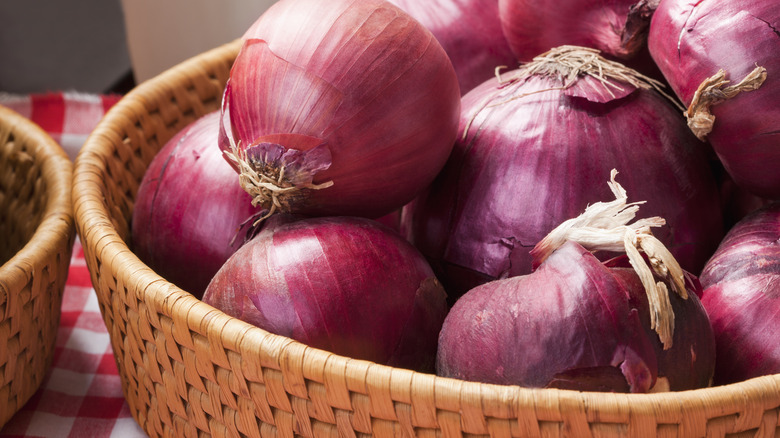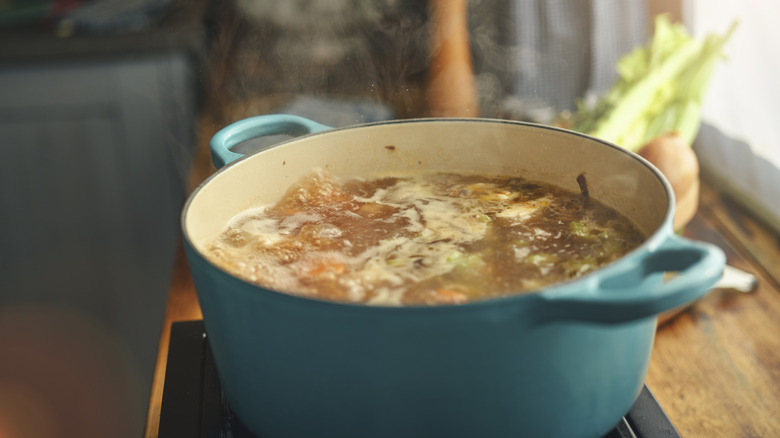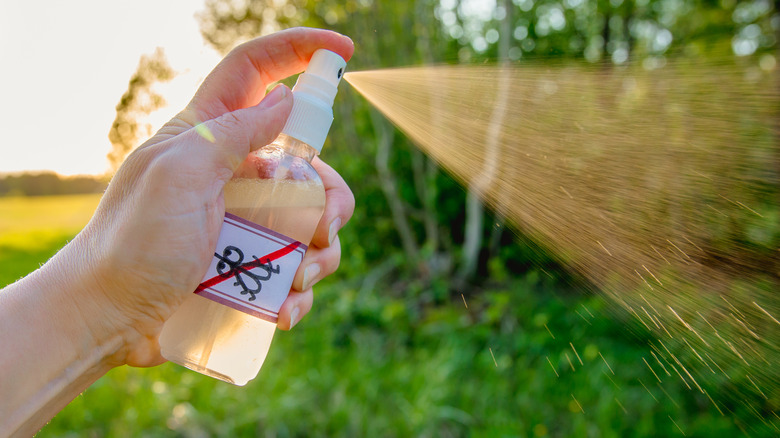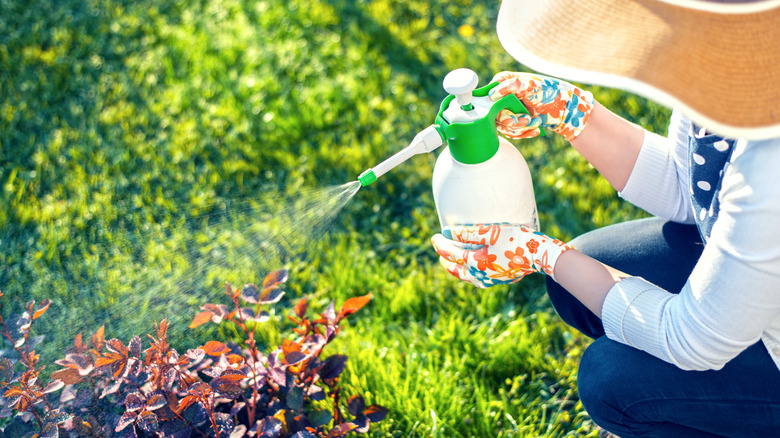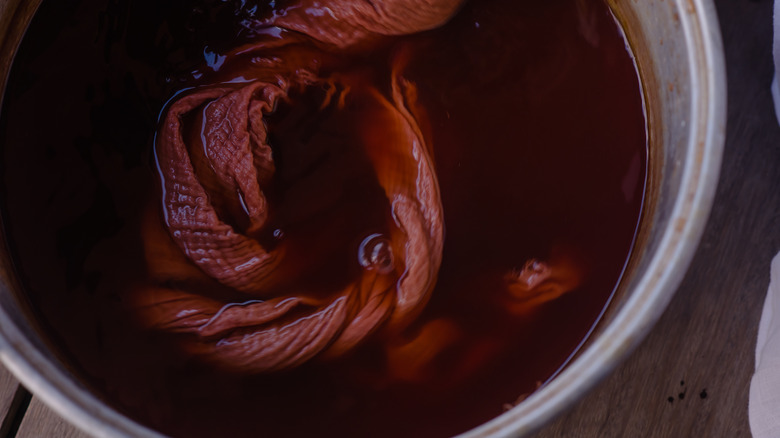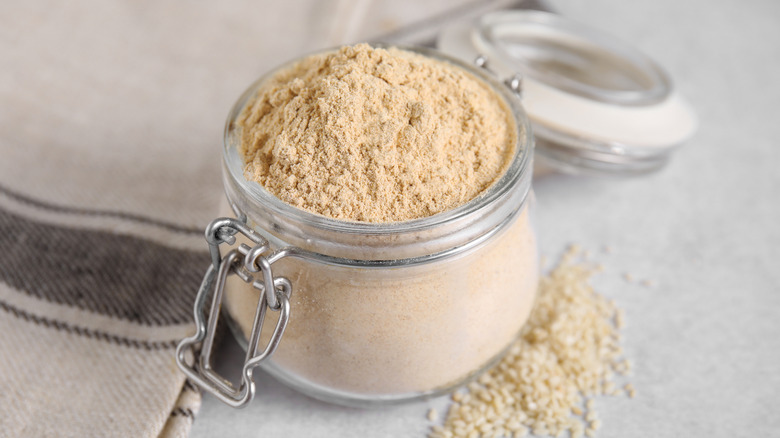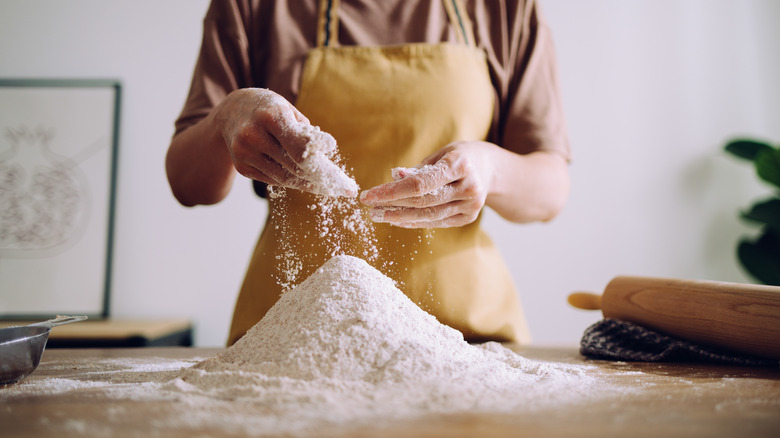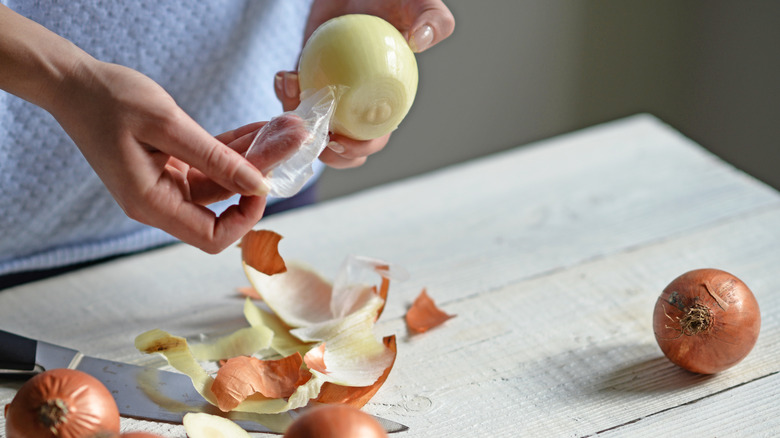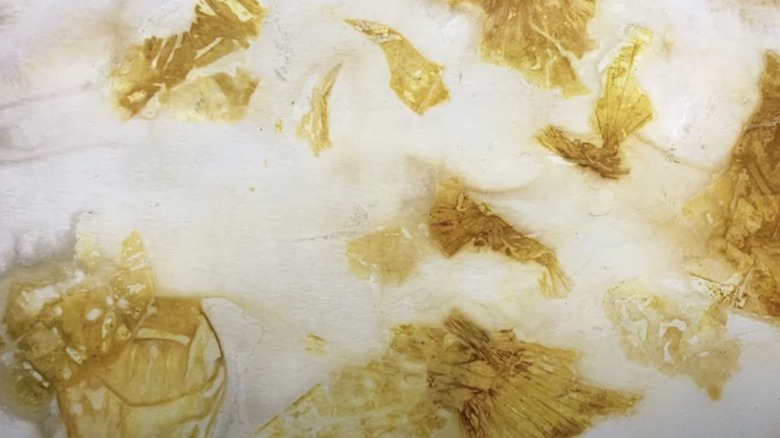10 Creative Ways To Use Onion Skins
If you're like most people, after you cut up an onion, you throw away the skins. This is the standard way we deal with food scraps, after all. But onion skins have some surprising uses and benefits you might not be aware of, which means it's worth it to think twice before tossing them. For one, onion skins offer plenty of health benefits because of their antioxidants, anti-inflammatory properties, and more. This on its own is a great reason to get some use out of onion skins rather than throwing them away.
But the fact that they're good for your health isn't the only reason to hold onto onion skins. Any time you can upcycle something you would normally put in the trash, it's great for the environment. It means less waste ends up in landfills, reducing your environmental footprint and contributing to a more sustainable lifestyle. On top of that, upcycling can help decrease the demand for new materials. In other words, using onion skins for DIY projects, health tonics, or anything else equates to helping save the planet.
If you're not ready to use them right away, you can easily save your onion skins for later by sealing them tightly in a plastic bag and freezing them. Like any vegetable, freezing onion skins does not diminish their nutritional value. They'll basically be as good as new when you are ready to get therapeutic or creative with them.
Use onion skins to make soup broth more flavorful and nutritious
Onion skins are edible, but people don't usually eat them because of their tough and fibrous texture. However, that doesn't mean you should throw them away. Instead of getting rid of them directly after you peel them, you can add them to soup broth to enhance its nutritional value. Onion skins contain lots of nutrients, including quercetin and other antioxidants, dietary fiber, and calcium. This nutrient-rich profile is great for your overall health. Antioxidants help protect your body's cells from damage, dietary fiber supports digestive health, and calcium contributes to bone strength.
That means using onion skins to make soup broth is a simple yet effective way to boost your intake of these healthy nutrients. To make broth with onion skins, all you have to do is give them a good wash and then boil them. You can use them alone to make the broth or mix them with other ingredients like the rest of the onion, carrots, bay leaves, or anything else. Using red or yellow onion skins will not only make your soup stock especially flavorful, it will also give it a beautiful, rich color. If you don't want to eat the skins, you can strain them out when you're done boiling the broth.
Make a natural bug repellent using onion skins
Onion skins contain sulfur, which releases a strong scent that repels insects. For this reason, you can use the skins to create an effective homemade bug repellent. While this is useful to anyone, it's an especially attractive option if you're prone to getting mosquito bites and not so keen on the harsh chemicals used in commercial repellents. Onion repellent on its own can work wonders for keeping bugs away. However, if you want to make it even more potent, you might wan to add garlic skin, another sulfur-rich material.
Making onion repellent is easy. You simply boil several large onion skins in a liter of water. The more onion skins you include, the more potent your repellent will be. That being said, it does create a strong scent, so if you're planning to be around other people, you might want to avoid adding too many. Boiling the onion skins for five minutes or so is enough. Then, let the liquid cool, strain out the skins, and store the liquid at room temperature in a spray bottle. Spray your homemade repellent in the air in areas where you want to repel mosquitoes and other annoying insects. Be aware that while you can apply onion repellent directly to your skin, doing so may cause irritation, particularly if it's highly concentrated.
Use onion skins to make tea for various health benefits
Onion peels contain quercetin, which research has shown to have various health benefits, including antioxidant, anti-inflammatory, antiviral, cardiovascular, and anticancer properties. Because of this, people have been known to use quercetin for anti-aging, treating wounds, reducing allergies, reducing inflammation, and losing weight. This means that using onion peels to make tea could potentially offer some of these amazing health benefits.
You'll find the highest concentration of quercetin in red onions, though any onion skins will work. To make a soothing tea, pour boiling water over several onion skins and let them soak for around 15 minutes. Then, strain out the onion peels and drink up. If the flavor of onion tea doesn't sound all that appealing to you, you can also add sugar, ginger, honey, or cinnamon to make it more appetizing. Keep in mind that, as with any natural remedy, it's best to consult with your doctor before adding onion tea to your regular routine.
Use onion peels to make natural pesticide for your garden
Onion peels work well as a pesticide to keep bugs off your plants thanks to the compound acetogenin. Acetogenin can impair digestion in insects, which ends up killing them. A huge benefit of making pesticide from onion skins is that it's environmentally friendly, unlike commercially sold pesticides. Also, because the mixture is organic, the residue disappears pretty quickly, making it much safer to use around children and pets.
Making onion-skin pesticide is remarkably easy. You simply boil several onion skins in water for around five minutes. The more onion peels you use, the more concentrated your pesticide will be. After it cools, strain out the peels and pour the liquid into a spray bottle. Because this is a highly concentrated mixture, you'll want to add around two cups of water per one cup of onion-skin pesticide. This will allow you to spray it directly on infested plants to get rid of the pests. If you're using it to prevent pest infestation, dilute the liquid even more, using four cups of water per one cup of pesticide.
Use onion peels to create a fertilizer for your plants
Onion peels can be a valuable resource for your houseplants and garden. They are rich in flavonoids, phenols, tannins, and other nutrients, all of which make them an excellent plant fertilizer. Plus, they're an organic and cost-effective alternative to commercial fertilizer. Any type of onion skins will work, from yellow onions to red onions to shallots. One way to use them is by burying the onion peels in the dirt near your plants. As they decompose, they will naturally add nutrients like calcium and potassium to the soil to nourish your plants.
You can also make a nutrient-packed liquid fertilizer by soaking onion skins in a liter of room-temperature water for around 24 hours. During this time, the water absorbs the beneficial elements from the onion skins. Soaking the skins for longer will result in a more concentrated fertilizer. Be careful, as this might be too strong for some plants. Once they're done soaking, strain the liquid into a bottle to add to the soil of your plants as desired. This homemade fertilizer is a great way to keep your plants healthy and strong while minimizing waste.
Use onion peels to make natural dye
Using onion skins to make natural dye is a practice that has deep historical roots. Ancient Egyptians, Native Americans, Medieval Europeans, and various other cultures have utilized onion skins to dye textiles and more. Boiling onion skins extracts strong and versatile colors that can be used to dye fabric, Easter eggs, or even hair. The skins of any colored onion can be used, offering a spectrum of earthy hues, from golden yellows to deep reds and purples.
Because onion skins contain lots of natural tannins, the dye binds especially well to fabric fibers, leading to long-lasting and vibrant colors. Cotton or linen fabrics will give you the best results thanks to their cellulose fibers that easily absorb dyes. Onion-skin dye is both organic and incredibly simple to make right in your kitchen. First, boil plenty of onion skins in water for around an hour. This is enough time to extract rich, earthy colors. Then, strain out the skins. Finally, soak your fabric, eggs, or hair in the dye bath. The amount of soaking time directly correlates to the intensity of the color.
Use onion skins for homemade onion powder
Instead of buying onion powder from the store, you can use discarded onion skins to make your own. The skins of five or six medium or large onions will make around 1/4 cup of onion powder. If it takes you a while to save up enough skins, you can prevent mold by freezing them in a sealed plastic bag in the meantime. When you're ready to make the onion powder, scatter the onion skins across a baking sheet and bake them at 150 degrees for around three hours. This will make sure they are nice and dry. After that, crush them up, either by hand or in a blender or food processor. Just like any spice, store your homemade onion powder in an air-tight jar.
Making homemade onion powder from discarded onion skins is not only a great way to reduce food waste but also allows you to experiment with different flavors. The onion powder you'd buy at the grocery store is typically made from white or yellow onions. When you make your own, you can try other varieties, such as red onions, sweet onions, or shallots. Plus, you'll have the satisfaction of knowing you created something delicious, all while minimizing your environmental footprint.
Enrich your flour with onion skins
White flour is primarily only a source of carbs, and while we all love carbs, it'd be nice to get some better health benefits from it. To make flour more nutritious, you can add ground-up onion skins, which are rich in the antioxidant and antimicrobial compound quercetin, among other nutrients. Adding onion skins to your flour also gives a subtle flavor to it, which will infuse itself into your recipes. Different types of onion skins, from red to white to sweet onions, will impact the flavor profile of the flour. This could be a fun and creative way to play chef, giving your savory dishes a unique twist.
Using onion skins to enrich flour has other benefits, too. Research shows that they can act as a natural preservative, which could increase the shelf-life of anything you bake or cook with it. A lot of baked goods, like bread and muffins, don't last that long, so using onion-skin-enriched flour may be a way to prolong their freshness.
Infuse vinegar with onion skins to add subtle flavor and nutrition
Vinegar on its own, whether it's Balsamic, apple cider, or wine vinegar, has a tangy and acidic taste. Infusing it with onion skins will introduce subtle yet complex layers of flavor, adding a slighter sweeter earthiness to vinegar's bite. The variety of onion skin you add will impact how the flavor of the vinegar turns out. For instance, red onions will lead to a slightly sweeter and more robust flavor, while yellow onions will likely offer a milder taste profile.
Beyond flavor enhancement, infusing vinegar with onion skins also adds some nutritional value. Onion skins contain beneficial compounds like quercetin, which has antioxidant and anti-inflammatory properties, among others. To infuse vinegar with onion skins, start by collecting a generous amount of clean and dry onion skins. Place the onion skins in a clean glass jar and cover them with the vinegar of your choice. Seal the jar tightly and store it in a cool, dark place for two to four weeks, allowing the flavors to blend and develop. Every couple of days, shake the bottle to help distribute the flavor. Once infused to your desired taste, strain out the onion skins from the vinegar and transfer the infused vinegar to a clean bottle.
Use onion skins to make art
When creating analog visual art, you don't have to limit yourself to the standard materials, like store-bought paint, charcoal, and pencil. Creativity knows no bounds, which leaves a lot of room for experimentation. In that vein, instead of throwing your onion peels in the trash, you can use them to make art. Some people use them directly, cutting and pasting them to paintings, collages, and other art projects. Others have used onion skins in a process called eco-printing, where you use them to transfer their natural patterns and colors onto paper or fabric.
You can even make your own paint with onion skins, courtesy of their strong natural pigments. To do this, you'll put lots of dried-out onion skins in a pot of water and boil them on low for an hour or more until the liquid reduces and thickens. As the onion skins simmer, their color releases into the water, creating a vibrant hue. The more onion skins in the batch and the longer they boil, the stronger the color will be. Once it cools, you'll be left with an eco-friendly, biodegradable, non-toxic homemade paint that shows off the earthy tones of the onion skins.
